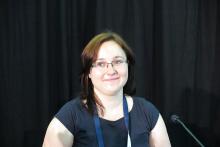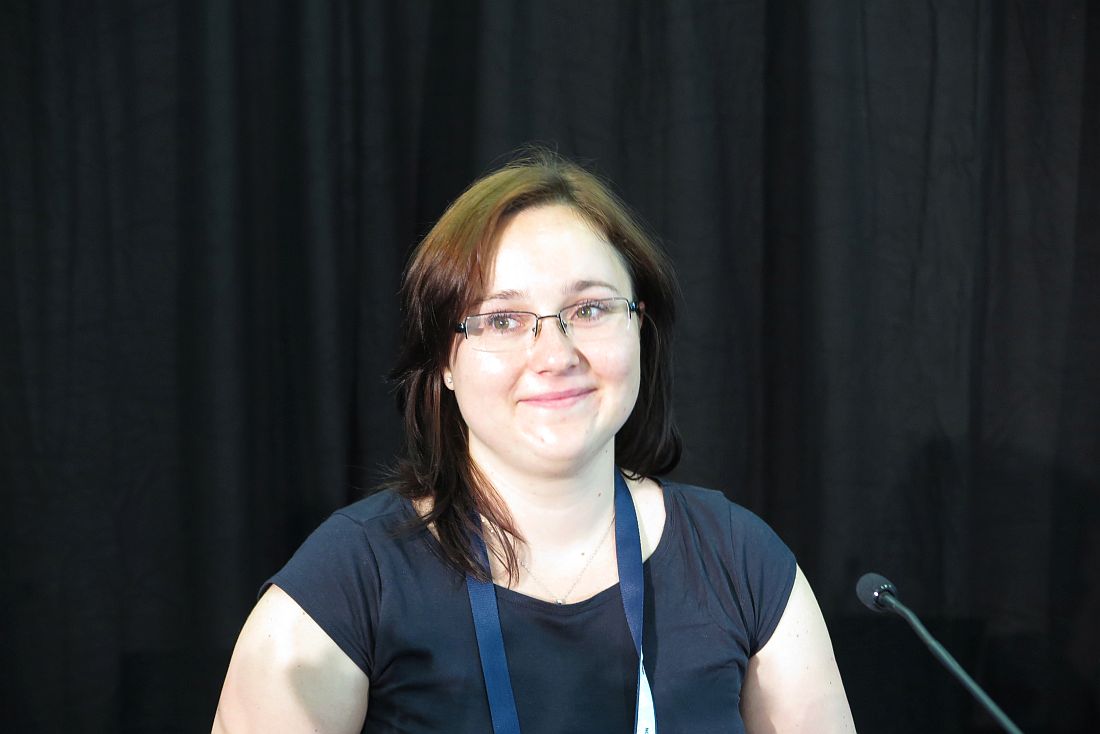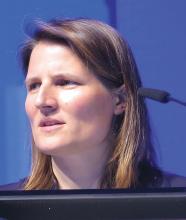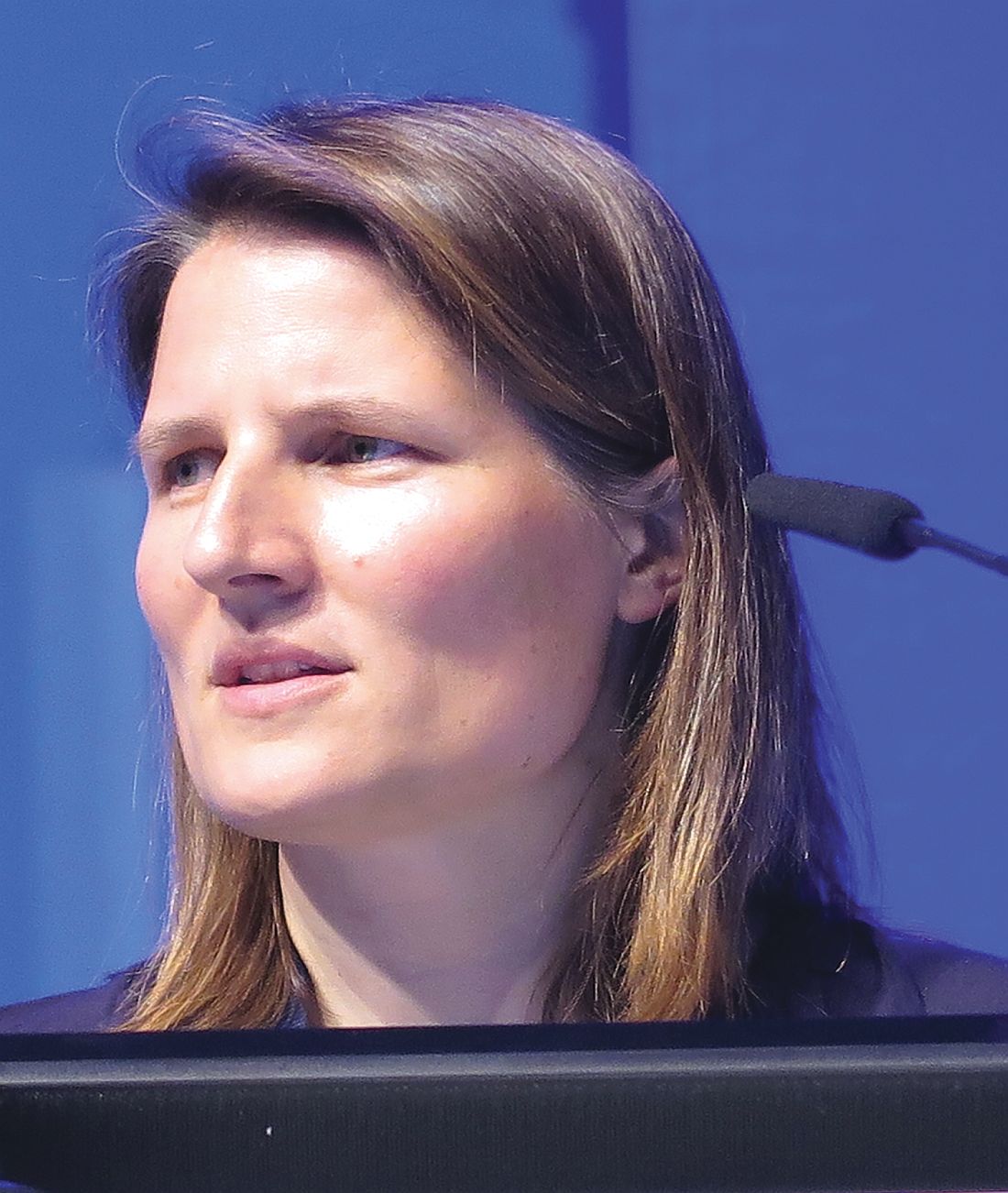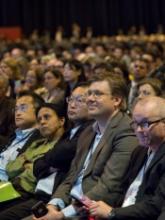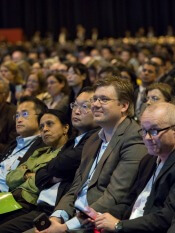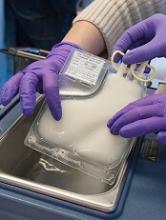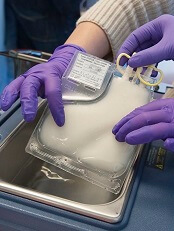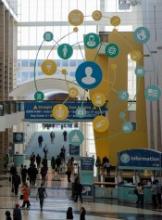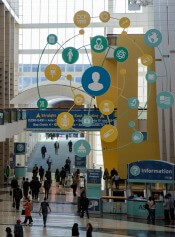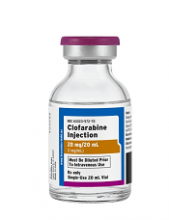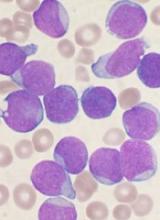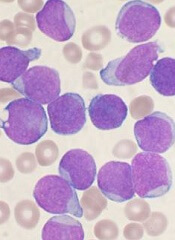User login
CSF p-Tau predicts neurocognitive sequelae in survivors of childhood cancer
A small retrospective study of survivors of childhood acute lymphoblastic leukemia (ALL) or non-Hodgkin lymphoma (NHL) has found that phosphorylated Tau (p-Tau) in patients’ cerebrospinal fluid (CSF) is a predictor of late neurocognitive consequences.
Investigators compared intellectual performance, memory, and executive functioning between survivors and control subjects and observed that CSF levels of p-Tau during treatment and total intrathecal methotrexate dose negatively correlated with intellectual performance.
They suggest that identifying at-risk children early “could inspire interventions to prevent or remediate chemotherapy-induced cognitive sequelae.”
The investigators enrolled 31 nonirradiated adults, 27 who had had ALL and 4 NHL. They compared the survivors to 35 age-matched controls.
All study participants were a mean age of 21.5 years (range, 16.1–29.8). The mean age of the survivors at diagnosis was 6.4 years.
"Our team collected samples of brain fluid during the cancer treatment,” Rudi D’Hooge, PhD, of KU Leuven in Belgium, said. “We analyzed the p-Tau levels to measure the damage to the brain cells."
Investigators assessed intelligence, memory, and executive function using Wechsler Adult Intelligence Scale (WAIS IV), Rey Auditory Verbal Learning Test (AVLT), and Amsterdam Neuropsychological Tasks (ANT), respectively.
Statistical analysis included two-sided, one-way analysis of covariance (ANCOVA) with survivor group vs control group as an independent factor. Parental socioeconomic status was a covariate.
Dr D’Hooge and colleagues published their findings in JNCI, the Journal of the National Cancer Institute.
Findings
Investigators found that survivors had statistically significant lower total intelligence (P=0.001), verbal intelligence (P=0.02), and performance intelligence (P=0.007) quotients than controls.
They also found a negative correlation between CSF p-Tau, but not CSF Tau, levels and total intelligence (P=0.02), verbal intelligence (P=0.001), and performance intelligence (P=0.04) quotients.
Only performance intelligence was negatively correlated with total intrathecal methotrexate (P=0.007).
And because total intrathecal methotrexate dose and CSF p-Tau were not significantly correlated (P=0.29), the investigators believe intervening factors increase CSF p-Tau independently from methotrexate dose.
Results of subset tests revealed that cognitive flexibility (set-shifting and working memory), and processing speed were affected (P<0.05).
However, long-term memory, focused and sustained attention, and inhibition appeared unaffected (P>0.05).
The investigators believe these differences in vulnerability of cognitive functions parallel patient age at time of development.
For example, long-term memory, focused and sustained attention, and inhibition develop before children reach 6 years, the mean age at which the survivor cohort was diagnosed.
But set-shifting, working memory, and processing speed mature during adolescence, after the patients were diagnosed and treated.
Limitations of the study, according to the investigators, include its retrospective and cross-sectional design, the relatively small sample size, and the lack of pretreatment neurocognitive data.
Nevertheless, they believe the study should encourage the use of the CSF biomarker, intrathecal methotrexate dose, and age at therapy initiation in neurotoxicity assessments to identify children at risk for long-term sequelae.
"If we systematically measure these p-Tau levels in the future," Iris Elens, MD, also of KU Leuven, said, "we can offer specific help to children with high values. With early coaching aimed at the most relevant functions we can prevent problems that would otherwise manifest 10 to 15 years after the treatment."
The Olivia Hendrickx Research Fund supported the study. ![]()
A small retrospective study of survivors of childhood acute lymphoblastic leukemia (ALL) or non-Hodgkin lymphoma (NHL) has found that phosphorylated Tau (p-Tau) in patients’ cerebrospinal fluid (CSF) is a predictor of late neurocognitive consequences.
Investigators compared intellectual performance, memory, and executive functioning between survivors and control subjects and observed that CSF levels of p-Tau during treatment and total intrathecal methotrexate dose negatively correlated with intellectual performance.
They suggest that identifying at-risk children early “could inspire interventions to prevent or remediate chemotherapy-induced cognitive sequelae.”
The investigators enrolled 31 nonirradiated adults, 27 who had had ALL and 4 NHL. They compared the survivors to 35 age-matched controls.
All study participants were a mean age of 21.5 years (range, 16.1–29.8). The mean age of the survivors at diagnosis was 6.4 years.
"Our team collected samples of brain fluid during the cancer treatment,” Rudi D’Hooge, PhD, of KU Leuven in Belgium, said. “We analyzed the p-Tau levels to measure the damage to the brain cells."
Investigators assessed intelligence, memory, and executive function using Wechsler Adult Intelligence Scale (WAIS IV), Rey Auditory Verbal Learning Test (AVLT), and Amsterdam Neuropsychological Tasks (ANT), respectively.
Statistical analysis included two-sided, one-way analysis of covariance (ANCOVA) with survivor group vs control group as an independent factor. Parental socioeconomic status was a covariate.
Dr D’Hooge and colleagues published their findings in JNCI, the Journal of the National Cancer Institute.
Findings
Investigators found that survivors had statistically significant lower total intelligence (P=0.001), verbal intelligence (P=0.02), and performance intelligence (P=0.007) quotients than controls.
They also found a negative correlation between CSF p-Tau, but not CSF Tau, levels and total intelligence (P=0.02), verbal intelligence (P=0.001), and performance intelligence (P=0.04) quotients.
Only performance intelligence was negatively correlated with total intrathecal methotrexate (P=0.007).
And because total intrathecal methotrexate dose and CSF p-Tau were not significantly correlated (P=0.29), the investigators believe intervening factors increase CSF p-Tau independently from methotrexate dose.
Results of subset tests revealed that cognitive flexibility (set-shifting and working memory), and processing speed were affected (P<0.05).
However, long-term memory, focused and sustained attention, and inhibition appeared unaffected (P>0.05).
The investigators believe these differences in vulnerability of cognitive functions parallel patient age at time of development.
For example, long-term memory, focused and sustained attention, and inhibition develop before children reach 6 years, the mean age at which the survivor cohort was diagnosed.
But set-shifting, working memory, and processing speed mature during adolescence, after the patients were diagnosed and treated.
Limitations of the study, according to the investigators, include its retrospective and cross-sectional design, the relatively small sample size, and the lack of pretreatment neurocognitive data.
Nevertheless, they believe the study should encourage the use of the CSF biomarker, intrathecal methotrexate dose, and age at therapy initiation in neurotoxicity assessments to identify children at risk for long-term sequelae.
"If we systematically measure these p-Tau levels in the future," Iris Elens, MD, also of KU Leuven, said, "we can offer specific help to children with high values. With early coaching aimed at the most relevant functions we can prevent problems that would otherwise manifest 10 to 15 years after the treatment."
The Olivia Hendrickx Research Fund supported the study. ![]()
A small retrospective study of survivors of childhood acute lymphoblastic leukemia (ALL) or non-Hodgkin lymphoma (NHL) has found that phosphorylated Tau (p-Tau) in patients’ cerebrospinal fluid (CSF) is a predictor of late neurocognitive consequences.
Investigators compared intellectual performance, memory, and executive functioning between survivors and control subjects and observed that CSF levels of p-Tau during treatment and total intrathecal methotrexate dose negatively correlated with intellectual performance.
They suggest that identifying at-risk children early “could inspire interventions to prevent or remediate chemotherapy-induced cognitive sequelae.”
The investigators enrolled 31 nonirradiated adults, 27 who had had ALL and 4 NHL. They compared the survivors to 35 age-matched controls.
All study participants were a mean age of 21.5 years (range, 16.1–29.8). The mean age of the survivors at diagnosis was 6.4 years.
"Our team collected samples of brain fluid during the cancer treatment,” Rudi D’Hooge, PhD, of KU Leuven in Belgium, said. “We analyzed the p-Tau levels to measure the damage to the brain cells."
Investigators assessed intelligence, memory, and executive function using Wechsler Adult Intelligence Scale (WAIS IV), Rey Auditory Verbal Learning Test (AVLT), and Amsterdam Neuropsychological Tasks (ANT), respectively.
Statistical analysis included two-sided, one-way analysis of covariance (ANCOVA) with survivor group vs control group as an independent factor. Parental socioeconomic status was a covariate.
Dr D’Hooge and colleagues published their findings in JNCI, the Journal of the National Cancer Institute.
Findings
Investigators found that survivors had statistically significant lower total intelligence (P=0.001), verbal intelligence (P=0.02), and performance intelligence (P=0.007) quotients than controls.
They also found a negative correlation between CSF p-Tau, but not CSF Tau, levels and total intelligence (P=0.02), verbal intelligence (P=0.001), and performance intelligence (P=0.04) quotients.
Only performance intelligence was negatively correlated with total intrathecal methotrexate (P=0.007).
And because total intrathecal methotrexate dose and CSF p-Tau were not significantly correlated (P=0.29), the investigators believe intervening factors increase CSF p-Tau independently from methotrexate dose.
Results of subset tests revealed that cognitive flexibility (set-shifting and working memory), and processing speed were affected (P<0.05).
However, long-term memory, focused and sustained attention, and inhibition appeared unaffected (P>0.05).
The investigators believe these differences in vulnerability of cognitive functions parallel patient age at time of development.
For example, long-term memory, focused and sustained attention, and inhibition develop before children reach 6 years, the mean age at which the survivor cohort was diagnosed.
But set-shifting, working memory, and processing speed mature during adolescence, after the patients were diagnosed and treated.
Limitations of the study, according to the investigators, include its retrospective and cross-sectional design, the relatively small sample size, and the lack of pretreatment neurocognitive data.
Nevertheless, they believe the study should encourage the use of the CSF biomarker, intrathecal methotrexate dose, and age at therapy initiation in neurotoxicity assessments to identify children at risk for long-term sequelae.
"If we systematically measure these p-Tau levels in the future," Iris Elens, MD, also of KU Leuven, said, "we can offer specific help to children with high values. With early coaching aimed at the most relevant functions we can prevent problems that would otherwise manifest 10 to 15 years after the treatment."
The Olivia Hendrickx Research Fund supported the study. ![]()
T receptor diversity may predict BCP-ALL response to blinatumomab
MADRID – For patients with relapsed or refractory B-cell precursor acute lymphoblastic leukemia (BCP-ALL), an extensive and diverse T-cell receptor repertoire may be predictive of response to blinatumomab (Blincyto), investigators suggest.
Patients with responses to blinatumomab had a significantly more diverse T-cell receptor–beta (TRB) gene repertoire at the time of screening, compared with patients who would go on to have minimal residual disease after starting on blinatumomab therapy, reported Michaela Kotrova, MD, from the 2nd Faculty of Medicine Charles University and University Hospital Motol in Prague, Czech Republic.
Blinatumomab is a bispecific T-cell engager designed to direct cytotoxic T cells to cancer cells expressing the CD19 receptor. Although it can induce high remission rates in patients with relapsed/refractory BCP-ALL and has been shown to nearly double overall survival among patients with relapsed/refractory BCP-ALL negative for the Philadelphia chromosome, about half of patients do not achieve a minimal residual disease response. This finding prompted the investigators to determine whether differences in the TRB repertoire could have an effect on individual patient responses to blinatumomab.
They performed next-generation sequencing of immunoglobulin and T-cell receptor gene rearrangements to evaluate the diversity of the repertoire, which can have a profound impact on health.
Dr. Kotrova noted that, in young people, there may be as many as 120 million different TRB gene rearrangements, and the more the merrier because a higher diversity repertoire is capable of protecting people from a large variety of pathogens.
They compared the diversity of the TRB repertoire in 114 patients who were either responders to blinatumomab salvage therapy or who had measurable minimal residual disease (persisters).
They found that there was significantly greater probability than mere chance that the TRB repertoire before blinatumomab administration was more diverse in patients with responses, compared with those without responses.
On day 15 of the first cycle of blinatumomab therapy, there was no significant difference in TRB repertoire between responders and persisters, but, by day 29, there was a sharper and statistically significant increase in repertoire diversity but no significant increase among nonresponders.
Their findings raise the intriguing possibility that response to blinatumomab could be predicted by repertoire diversity prior to the start of therapy, but further studies with larger patient cohorts will be necessary to confirm this, Dr. Kotrova said.
The study was supported by Amgen. Dr. Kotrova had no relevant disclosures.
MADRID – For patients with relapsed or refractory B-cell precursor acute lymphoblastic leukemia (BCP-ALL), an extensive and diverse T-cell receptor repertoire may be predictive of response to blinatumomab (Blincyto), investigators suggest.
Patients with responses to blinatumomab had a significantly more diverse T-cell receptor–beta (TRB) gene repertoire at the time of screening, compared with patients who would go on to have minimal residual disease after starting on blinatumomab therapy, reported Michaela Kotrova, MD, from the 2nd Faculty of Medicine Charles University and University Hospital Motol in Prague, Czech Republic.
Blinatumomab is a bispecific T-cell engager designed to direct cytotoxic T cells to cancer cells expressing the CD19 receptor. Although it can induce high remission rates in patients with relapsed/refractory BCP-ALL and has been shown to nearly double overall survival among patients with relapsed/refractory BCP-ALL negative for the Philadelphia chromosome, about half of patients do not achieve a minimal residual disease response. This finding prompted the investigators to determine whether differences in the TRB repertoire could have an effect on individual patient responses to blinatumomab.
They performed next-generation sequencing of immunoglobulin and T-cell receptor gene rearrangements to evaluate the diversity of the repertoire, which can have a profound impact on health.
Dr. Kotrova noted that, in young people, there may be as many as 120 million different TRB gene rearrangements, and the more the merrier because a higher diversity repertoire is capable of protecting people from a large variety of pathogens.
They compared the diversity of the TRB repertoire in 114 patients who were either responders to blinatumomab salvage therapy or who had measurable minimal residual disease (persisters).
They found that there was significantly greater probability than mere chance that the TRB repertoire before blinatumomab administration was more diverse in patients with responses, compared with those without responses.
On day 15 of the first cycle of blinatumomab therapy, there was no significant difference in TRB repertoire between responders and persisters, but, by day 29, there was a sharper and statistically significant increase in repertoire diversity but no significant increase among nonresponders.
Their findings raise the intriguing possibility that response to blinatumomab could be predicted by repertoire diversity prior to the start of therapy, but further studies with larger patient cohorts will be necessary to confirm this, Dr. Kotrova said.
The study was supported by Amgen. Dr. Kotrova had no relevant disclosures.
MADRID – For patients with relapsed or refractory B-cell precursor acute lymphoblastic leukemia (BCP-ALL), an extensive and diverse T-cell receptor repertoire may be predictive of response to blinatumomab (Blincyto), investigators suggest.
Patients with responses to blinatumomab had a significantly more diverse T-cell receptor–beta (TRB) gene repertoire at the time of screening, compared with patients who would go on to have minimal residual disease after starting on blinatumomab therapy, reported Michaela Kotrova, MD, from the 2nd Faculty of Medicine Charles University and University Hospital Motol in Prague, Czech Republic.
Blinatumomab is a bispecific T-cell engager designed to direct cytotoxic T cells to cancer cells expressing the CD19 receptor. Although it can induce high remission rates in patients with relapsed/refractory BCP-ALL and has been shown to nearly double overall survival among patients with relapsed/refractory BCP-ALL negative for the Philadelphia chromosome, about half of patients do not achieve a minimal residual disease response. This finding prompted the investigators to determine whether differences in the TRB repertoire could have an effect on individual patient responses to blinatumomab.
They performed next-generation sequencing of immunoglobulin and T-cell receptor gene rearrangements to evaluate the diversity of the repertoire, which can have a profound impact on health.
Dr. Kotrova noted that, in young people, there may be as many as 120 million different TRB gene rearrangements, and the more the merrier because a higher diversity repertoire is capable of protecting people from a large variety of pathogens.
They compared the diversity of the TRB repertoire in 114 patients who were either responders to blinatumomab salvage therapy or who had measurable minimal residual disease (persisters).
They found that there was significantly greater probability than mere chance that the TRB repertoire before blinatumomab administration was more diverse in patients with responses, compared with those without responses.
On day 15 of the first cycle of blinatumomab therapy, there was no significant difference in TRB repertoire between responders and persisters, but, by day 29, there was a sharper and statistically significant increase in repertoire diversity but no significant increase among nonresponders.
Their findings raise the intriguing possibility that response to blinatumomab could be predicted by repertoire diversity prior to the start of therapy, but further studies with larger patient cohorts will be necessary to confirm this, Dr. Kotrova said.
The study was supported by Amgen. Dr. Kotrova had no relevant disclosures.
AT EHA 2017
Key clinical point: T-cell receptor–beta diversity is important for protection against a wide variety of pathogens.
Major finding: Patients with responses to blinatumomab had a significantly more diverse TRB gene repertoire at the time of screening, compared with patients who would go on to have minimal residual disease after starting on blinatumomab therapy.
Data source: A next-generation sequencing study of samples from 114 patients with relapsed/refractory B-cell precursor acute lymphocytic leukemia.
Disclosures: The study was supported by Amgen. Dr. Kotrova had no relevant disclosures.
Infections may trigger leukemia in the genetically susceptible
MADRID – The evidence thus far comes only from animal models, but commonly encountered childhood infections may be able to trigger the development of leukemia in those children with certain genetic predispositions to B-cell precursor acute lymphoblastic leukemia (BCP-ALL).
Mice genetically modified to mimic BCP-ALL susceptibility and its most common subtype (ETV6-RUNX1 BCP-ALL) developed leukemia only after exposure to a common infectious environment.
“The mechanism that takes place in preleukemic cells after the mice were exposed to infection was different in the two mouse models,” she said at a briefing prior to her presentation of the data at the annual congress of the European Hematology Association.
“This is another piece that will, hopefully, contribute to the picture of how exposure to infection can contribute to leukemic development” and may lead to novel approaches for leukemia prevention, she added.
The possibility that exposure to infectious pathogens could trigger leukemia has been bandied about for a century, based in part on observations that leukemia is the most common malignancy in children, with a still unexplained peak incidence between the ages of 2 and 6 years, Dr. Hauer noted.
To explore a possible link, she and her colleagues developed and characterized the aforementioned mice mimicking BCP-ALL with the BCR-ABL1 transcription and ETV6-RUNX1 BCP-ALL, in addition to a previously described Pax5+/- infection model. Some of all three mouse models were exposed not to specific pathogens but to a common laboratory environment, where they could be expected to acquire various infections at 2-3 months of age, and some were kept in a sterile environment designed to reduce transmission of pathogens. Wild-type mice were used as controls.
They observed that the Pax5+/- and ETV6-RUNX1 mice developed BCP-ALL only after exposure to common pathogens. In contrast, the BCR-ABL1p190 mice developed BCP-ALL independent of exposure to common infection.
They also determined that the mechanism leading to leukemia in the Pax5+/- mice was related to constitutive activations of mutations in the Janus kinase (JAK)3 pathway in susceptible B cell precursors, whereas the ETV6-RUNX1 mice developed BCP-ALL at a low penetrance (10.75%, 10 of 93) with a CD19-positive, B220-positive, immunoglobulin M-negative cell surface phenotype, manifested by blast cells in peripheral blood and a clonal immature B-cell receptor rearrangement.
In mice, norovirus and hepatitis C virus may be some of the pathogens most closely linked to risk of leukemia, but it’s likely that other viruses and parasitic infections will turn out to be the culprits in humans, Dr. Hauer said.
The findings raise the possibility of an unexpected link between leukemia and the so-called “hygiene hypothesis” linking childhood asthma, allergies, and atopic skin conditions to a lack of early exposure to a multiplicity of pathogens. In many developed countries, children are relatively protected from exposure to many different pathogens and may not encounter infectious agents until entering preschool or kindergarten, Dr. Hauer commented.
The study was supported by German Cancer Aid, the Jose Carreras Leukemia Foundation, and other charitable agencies. Dr. Hauer reported no relevant disclosures.
MADRID – The evidence thus far comes only from animal models, but commonly encountered childhood infections may be able to trigger the development of leukemia in those children with certain genetic predispositions to B-cell precursor acute lymphoblastic leukemia (BCP-ALL).
Mice genetically modified to mimic BCP-ALL susceptibility and its most common subtype (ETV6-RUNX1 BCP-ALL) developed leukemia only after exposure to a common infectious environment.
“The mechanism that takes place in preleukemic cells after the mice were exposed to infection was different in the two mouse models,” she said at a briefing prior to her presentation of the data at the annual congress of the European Hematology Association.
“This is another piece that will, hopefully, contribute to the picture of how exposure to infection can contribute to leukemic development” and may lead to novel approaches for leukemia prevention, she added.
The possibility that exposure to infectious pathogens could trigger leukemia has been bandied about for a century, based in part on observations that leukemia is the most common malignancy in children, with a still unexplained peak incidence between the ages of 2 and 6 years, Dr. Hauer noted.
To explore a possible link, she and her colleagues developed and characterized the aforementioned mice mimicking BCP-ALL with the BCR-ABL1 transcription and ETV6-RUNX1 BCP-ALL, in addition to a previously described Pax5+/- infection model. Some of all three mouse models were exposed not to specific pathogens but to a common laboratory environment, where they could be expected to acquire various infections at 2-3 months of age, and some were kept in a sterile environment designed to reduce transmission of pathogens. Wild-type mice were used as controls.
They observed that the Pax5+/- and ETV6-RUNX1 mice developed BCP-ALL only after exposure to common pathogens. In contrast, the BCR-ABL1p190 mice developed BCP-ALL independent of exposure to common infection.
They also determined that the mechanism leading to leukemia in the Pax5+/- mice was related to constitutive activations of mutations in the Janus kinase (JAK)3 pathway in susceptible B cell precursors, whereas the ETV6-RUNX1 mice developed BCP-ALL at a low penetrance (10.75%, 10 of 93) with a CD19-positive, B220-positive, immunoglobulin M-negative cell surface phenotype, manifested by blast cells in peripheral blood and a clonal immature B-cell receptor rearrangement.
In mice, norovirus and hepatitis C virus may be some of the pathogens most closely linked to risk of leukemia, but it’s likely that other viruses and parasitic infections will turn out to be the culprits in humans, Dr. Hauer said.
The findings raise the possibility of an unexpected link between leukemia and the so-called “hygiene hypothesis” linking childhood asthma, allergies, and atopic skin conditions to a lack of early exposure to a multiplicity of pathogens. In many developed countries, children are relatively protected from exposure to many different pathogens and may not encounter infectious agents until entering preschool or kindergarten, Dr. Hauer commented.
The study was supported by German Cancer Aid, the Jose Carreras Leukemia Foundation, and other charitable agencies. Dr. Hauer reported no relevant disclosures.
MADRID – The evidence thus far comes only from animal models, but commonly encountered childhood infections may be able to trigger the development of leukemia in those children with certain genetic predispositions to B-cell precursor acute lymphoblastic leukemia (BCP-ALL).
Mice genetically modified to mimic BCP-ALL susceptibility and its most common subtype (ETV6-RUNX1 BCP-ALL) developed leukemia only after exposure to a common infectious environment.
“The mechanism that takes place in preleukemic cells after the mice were exposed to infection was different in the two mouse models,” she said at a briefing prior to her presentation of the data at the annual congress of the European Hematology Association.
“This is another piece that will, hopefully, contribute to the picture of how exposure to infection can contribute to leukemic development” and may lead to novel approaches for leukemia prevention, she added.
The possibility that exposure to infectious pathogens could trigger leukemia has been bandied about for a century, based in part on observations that leukemia is the most common malignancy in children, with a still unexplained peak incidence between the ages of 2 and 6 years, Dr. Hauer noted.
To explore a possible link, she and her colleagues developed and characterized the aforementioned mice mimicking BCP-ALL with the BCR-ABL1 transcription and ETV6-RUNX1 BCP-ALL, in addition to a previously described Pax5+/- infection model. Some of all three mouse models were exposed not to specific pathogens but to a common laboratory environment, where they could be expected to acquire various infections at 2-3 months of age, and some were kept in a sterile environment designed to reduce transmission of pathogens. Wild-type mice were used as controls.
They observed that the Pax5+/- and ETV6-RUNX1 mice developed BCP-ALL only after exposure to common pathogens. In contrast, the BCR-ABL1p190 mice developed BCP-ALL independent of exposure to common infection.
They also determined that the mechanism leading to leukemia in the Pax5+/- mice was related to constitutive activations of mutations in the Janus kinase (JAK)3 pathway in susceptible B cell precursors, whereas the ETV6-RUNX1 mice developed BCP-ALL at a low penetrance (10.75%, 10 of 93) with a CD19-positive, B220-positive, immunoglobulin M-negative cell surface phenotype, manifested by blast cells in peripheral blood and a clonal immature B-cell receptor rearrangement.
In mice, norovirus and hepatitis C virus may be some of the pathogens most closely linked to risk of leukemia, but it’s likely that other viruses and parasitic infections will turn out to be the culprits in humans, Dr. Hauer said.
The findings raise the possibility of an unexpected link between leukemia and the so-called “hygiene hypothesis” linking childhood asthma, allergies, and atopic skin conditions to a lack of early exposure to a multiplicity of pathogens. In many developed countries, children are relatively protected from exposure to many different pathogens and may not encounter infectious agents until entering preschool or kindergarten, Dr. Hauer commented.
The study was supported by German Cancer Aid, the Jose Carreras Leukemia Foundation, and other charitable agencies. Dr. Hauer reported no relevant disclosures.
AT EHA 2017
Key clinical point: This study suggests a link between acute lymphocytic leukemia development and infections in some genetically predisposed children.
Major finding: Mouse models of two types of B-cell precursor ALL developed leukemia only after exposure to infections.
Data source: A study of factors related to the development of childhood ALL using genetically modified mouse models.
Disclosures: The study was supported by German Cancer Aid, the Jose Carreras Leukemia Foundation, and other charitable agencies. Dr. Hauer reported no relevant disclosures.
Neurotoxicity needs separate treatment from CRS in CAR T-cell therapy
CHICAGO – The neurotoxicity in adult patients with relapsed or refractory B-cell acute lymphocytic leukemia (B-ALL) treated with CD19 CAR T cells is a separate process from cytokine release syndrome (CRS) and needs to be treated separately, according to a new study presented at the American Society of Clinical Oncology annual meeting (abstract 3019).
CD19-specific CAR-modified T cells produce high, durable anti-tumor activity, but can be associated with treatment-related toxicities, including CRS and neurotoxicity.
Neurotoxicity is poorly understood and it hasn't been clear where to focus further research, said Bianca Santomasso, MD, of Memorial Sloan Kettering Cancer Center in New York, New York.
Dr Santomasso and colleagues had conducted a phase 1 study using autologous 19-CAR T cells in adult patients with relapsing/refractory B-ALL, with high response rates.
To gain a better understanding of CD19 CAR T-cell-associated neurotoxicity, they analyzed clinical and research parameters after stratifying patients by neurotoxicity grade.
At ASCO, she reported neurologic symptom presentation in 51 adult patients with relapsed/refractory B-ALL who were treated with CAR T cells following conditioning chemotherapy, along with cerebrospinal fluid (CSF) data and neuroimaging findings associated with neurotoxicity.
Of the 51 patients treated, 10 patients (20%) developed mild neurologic symptoms (grade 1 or 2) and 21 patients (41%) developed severe neurotoxicity (grade 3 or 4).
No grade 5 neurotoxicity or diffuse cerebral edema occurred and, in all but one case, neurologic symptoms fully resolved.
Fourteen patients (27.4%) developed severe CRS; 6 patients received tocilizumab alone, 13 patients tocilizumab plus steroids, 4 patients steroids alone, and 29 patients supportive care.
The cytokines IL-6, IL-8, IL-10, interferon gamma, and granulocyte-colony stimulating factor were elevated in CSF over serum at the time of neurotoxicity and correlated with CSF protein levels.
“We found no significant correlation between neurotoxicity grade and the CAR T-cell concentration in the CSF during neurotoxicity,” Dr Santomasso said. “Instead, CSF protein level was correlated with neurotoxicity grade.”
Neurotoxicity was associated with peak CAR T-cell expansion in the blood and peak serum levels of several cytokines associated with T-cell activation or proliferation, she said.
“CAR T cells traffic to the CSF of patients with all grades of neurotoxicity, including grade 0, and there is no significant correlation between CAR T cells in CSF at the time of acute neurotoxicity and grade of neurotoxicity,” Dr Santomasso reported. “This suggests that neurotoxicity is not directly mediated by CAR T cells, which cross into the spinal fluid.”
Some chemokines/cytokines are elevated in CSF relative to serum, suggesting CNS-specific production of these factors, she said.
“Clinicians treating these patients tend to lump CRS and neurotoxicity together. Now we have an increasing understanding that these adverse events are separated in time and possibly in underlying pathology,” said Dr Santomasso.
“Even when patients recover from CRS, they could still be at risk for neurotoxicity.”
She noted that the neurotoxicity symptoms that B-ALL patients develop in the setting of CAR T cells are manageable.
In a subset of patients with severe neurotoxicity, T2/FLAIR changes were observed, which resolved with steroids and neurologic symptom resolution. ![]()
CHICAGO – The neurotoxicity in adult patients with relapsed or refractory B-cell acute lymphocytic leukemia (B-ALL) treated with CD19 CAR T cells is a separate process from cytokine release syndrome (CRS) and needs to be treated separately, according to a new study presented at the American Society of Clinical Oncology annual meeting (abstract 3019).
CD19-specific CAR-modified T cells produce high, durable anti-tumor activity, but can be associated with treatment-related toxicities, including CRS and neurotoxicity.
Neurotoxicity is poorly understood and it hasn't been clear where to focus further research, said Bianca Santomasso, MD, of Memorial Sloan Kettering Cancer Center in New York, New York.
Dr Santomasso and colleagues had conducted a phase 1 study using autologous 19-CAR T cells in adult patients with relapsing/refractory B-ALL, with high response rates.
To gain a better understanding of CD19 CAR T-cell-associated neurotoxicity, they analyzed clinical and research parameters after stratifying patients by neurotoxicity grade.
At ASCO, she reported neurologic symptom presentation in 51 adult patients with relapsed/refractory B-ALL who were treated with CAR T cells following conditioning chemotherapy, along with cerebrospinal fluid (CSF) data and neuroimaging findings associated with neurotoxicity.
Of the 51 patients treated, 10 patients (20%) developed mild neurologic symptoms (grade 1 or 2) and 21 patients (41%) developed severe neurotoxicity (grade 3 or 4).
No grade 5 neurotoxicity or diffuse cerebral edema occurred and, in all but one case, neurologic symptoms fully resolved.
Fourteen patients (27.4%) developed severe CRS; 6 patients received tocilizumab alone, 13 patients tocilizumab plus steroids, 4 patients steroids alone, and 29 patients supportive care.
The cytokines IL-6, IL-8, IL-10, interferon gamma, and granulocyte-colony stimulating factor were elevated in CSF over serum at the time of neurotoxicity and correlated with CSF protein levels.
“We found no significant correlation between neurotoxicity grade and the CAR T-cell concentration in the CSF during neurotoxicity,” Dr Santomasso said. “Instead, CSF protein level was correlated with neurotoxicity grade.”
Neurotoxicity was associated with peak CAR T-cell expansion in the blood and peak serum levels of several cytokines associated with T-cell activation or proliferation, she said.
“CAR T cells traffic to the CSF of patients with all grades of neurotoxicity, including grade 0, and there is no significant correlation between CAR T cells in CSF at the time of acute neurotoxicity and grade of neurotoxicity,” Dr Santomasso reported. “This suggests that neurotoxicity is not directly mediated by CAR T cells, which cross into the spinal fluid.”
Some chemokines/cytokines are elevated in CSF relative to serum, suggesting CNS-specific production of these factors, she said.
“Clinicians treating these patients tend to lump CRS and neurotoxicity together. Now we have an increasing understanding that these adverse events are separated in time and possibly in underlying pathology,” said Dr Santomasso.
“Even when patients recover from CRS, they could still be at risk for neurotoxicity.”
She noted that the neurotoxicity symptoms that B-ALL patients develop in the setting of CAR T cells are manageable.
In a subset of patients with severe neurotoxicity, T2/FLAIR changes were observed, which resolved with steroids and neurologic symptom resolution. ![]()
CHICAGO – The neurotoxicity in adult patients with relapsed or refractory B-cell acute lymphocytic leukemia (B-ALL) treated with CD19 CAR T cells is a separate process from cytokine release syndrome (CRS) and needs to be treated separately, according to a new study presented at the American Society of Clinical Oncology annual meeting (abstract 3019).
CD19-specific CAR-modified T cells produce high, durable anti-tumor activity, but can be associated with treatment-related toxicities, including CRS and neurotoxicity.
Neurotoxicity is poorly understood and it hasn't been clear where to focus further research, said Bianca Santomasso, MD, of Memorial Sloan Kettering Cancer Center in New York, New York.
Dr Santomasso and colleagues had conducted a phase 1 study using autologous 19-CAR T cells in adult patients with relapsing/refractory B-ALL, with high response rates.
To gain a better understanding of CD19 CAR T-cell-associated neurotoxicity, they analyzed clinical and research parameters after stratifying patients by neurotoxicity grade.
At ASCO, she reported neurologic symptom presentation in 51 adult patients with relapsed/refractory B-ALL who were treated with CAR T cells following conditioning chemotherapy, along with cerebrospinal fluid (CSF) data and neuroimaging findings associated with neurotoxicity.
Of the 51 patients treated, 10 patients (20%) developed mild neurologic symptoms (grade 1 or 2) and 21 patients (41%) developed severe neurotoxicity (grade 3 or 4).
No grade 5 neurotoxicity or diffuse cerebral edema occurred and, in all but one case, neurologic symptoms fully resolved.
Fourteen patients (27.4%) developed severe CRS; 6 patients received tocilizumab alone, 13 patients tocilizumab plus steroids, 4 patients steroids alone, and 29 patients supportive care.
The cytokines IL-6, IL-8, IL-10, interferon gamma, and granulocyte-colony stimulating factor were elevated in CSF over serum at the time of neurotoxicity and correlated with CSF protein levels.
“We found no significant correlation between neurotoxicity grade and the CAR T-cell concentration in the CSF during neurotoxicity,” Dr Santomasso said. “Instead, CSF protein level was correlated with neurotoxicity grade.”
Neurotoxicity was associated with peak CAR T-cell expansion in the blood and peak serum levels of several cytokines associated with T-cell activation or proliferation, she said.
“CAR T cells traffic to the CSF of patients with all grades of neurotoxicity, including grade 0, and there is no significant correlation between CAR T cells in CSF at the time of acute neurotoxicity and grade of neurotoxicity,” Dr Santomasso reported. “This suggests that neurotoxicity is not directly mediated by CAR T cells, which cross into the spinal fluid.”
Some chemokines/cytokines are elevated in CSF relative to serum, suggesting CNS-specific production of these factors, she said.
“Clinicians treating these patients tend to lump CRS and neurotoxicity together. Now we have an increasing understanding that these adverse events are separated in time and possibly in underlying pathology,” said Dr Santomasso.
“Even when patients recover from CRS, they could still be at risk for neurotoxicity.”
She noted that the neurotoxicity symptoms that B-ALL patients develop in the setting of CAR T cells are manageable.
In a subset of patients with severe neurotoxicity, T2/FLAIR changes were observed, which resolved with steroids and neurologic symptom resolution. ![]()
Pembrolizumab enhances CAR T-cell persistence in relapsed ALL
CHICAGO—Three of 6 pediatric patients with relapsed or refractory acute lymphoblastic leukemia (ALL) whose CD19 chimeric antigen receptor (CAR) T cells did not persist even after reinfusion demonstrated persistence when the PD-1 checkpoint inhibitor pembrolizumab was added to the regimen.
CAR T cells can persist for months or even years and have the potential to mediate long-term disease control.
But some patients recover their normal B cells, which is a marker of loss of functional CAR T cells. These patients are at a higher risk of disease relapse.
Investigators, therefore, undertook a pilot study to determine whether PD-1 checkpoint pathway inhibition can improve CAR T persistence in these patients.
Shannon L. Maude, MD, of the Children’s Hospital of Philadelphia and the University of Pennsylvania Perelman School of Medicine, shared some of the patient cases in this pilot study at the ASCO 2017 Annual Meeting (Abstract 103*).
The investigators hypothesized that possible anti-murine immunogenicity could be causing poor CAR T-cell persistence, since the first CAR T developed used scFv domains of murine origin.
If T-cell exhaustion caused poor CAR T-cell persistence, immune checkpoints might play a role. In this case, combination with PD-1 checkpoint blockade could improve persistence, they hypothesized.
The investigators proposed to administer a repeat CAR T-cell infusion for relapsed or refractory ALL patients with poor persistence and add pembrolizumab after retreatment if the patients still had poor persistence. Patients were offered the option of another reinfusion prior to treatment with pembrolizumab if their CAR T-cell persistence continued to be poor.
Investigators added pembrolizumab no earlier than 14 days after infusion and only after patients recovered from cytokine release syndrome (CRS).
The infusions in the pilot study were humanized CART19 (huCART19, CTL119), unless otherwise specified.
Patient 1 – Pembrolizumab for partial response
This patient had no response to the prior murine CD19 CAR infusion, but responded well to infusion with huCART19 with good CAR T-cell proliferation.
By day 28, the patient had achieved a complete response (CR) in bone marrow but had a minimal residual disease (MRD) level of 1.2%.
At 7 weeks, the patient had a CD19+ relapse with low levels of huCART19.
Investigators added pembrolizumb on day 52 after infusion, and the patient had a modest increase in huCART19.
The patient had a temporary clearance of peripheral blasts followed by disease progression.
Patient 2 – Pembrolizumab for no response
This patient had a CD19+ relapse at 12 months after prior murine CD19 CAR infusion.
The patient was treated with huCART19, had good proliferation, but a rapid drop of CART19, and no response of the disease with a CD19+ relapse.
The patient had a reinfusion of huCART19 at 6 weeks and investigators added pembrolizumab on day 14 after reinfusion.
The patient experienced good huCART19 proliferation and prolonged persistence, but by day 28 had persistent disease, this time with decreased expression of CD19+ cells.
Patient 3 – Pembrolizumab for poor persistence
This patient had a CR with a prior murine CD19 CAR, but had poor persistence and early B cell recovery at 2 months.
The patient had a CD19+ relapse, was treated with huCART19, and had good proliferation again.
The patient achieved an MRD-negative CR, but because of short persistence and early B-cell recovery at 2 months, relapsed at 15 months.
The patient was reinfused at 17 months and pembrolizumab was added on day 14. The patient entered CR with prolonged persistence, but ultimately B-cell recovery occurred.
The patient was reinfused a third time, and pembrolizumab was added to the regimen every 3 weeks. The patient is experiencing prolonged persistence and continued B-cell aplasia.
Patient 4 – Pembrolizumab for poor persistence
This patient had achieved a CR with murine CAR19, but had a CD19+ relapse at 9 months. The patient then received huCART19, had good proliferation and achieved a CR, but had short persistence and B-cell recovery at 2 months.
The patient relapsed at 12 months and was reinfused with huCART19 at 14 months.
Pembrolizumab was added on day 14 after reinfusion, but the patient had no huCART19 proliferation, no response, and CD19+ MRD.
Patient 5 – Pembrolizumab for poor persistence
The patient responded to a prior murine CART19, but had a CD19+ relapse at 12 months.
The patient was infused with huCART19 and had good proliferation but short persistence. The patient was reinfused at 6 months, but again had short persistence.
The patient was reinfused again at 8 months because of B-cell recovery, and pembrolizumab was added on day 14 and administered every 3 weeks thereafter.
The patient is experiencing prolonged persistence and continued B-cell aplasia.
Patient 6 – Pembrolizumab for lymphomatous disease
This patient, who had widespread lymphadenopathy and M3 bone marrow, had not received prior CAR T cells and was treated for the first time with a murine CART19 for r/r ALL.
The patient had good expansion of CART19, but by day 28, PET scan showed widespread lymph node disease despite CR in the bone marrow.
The patient was given pembrolizumab on day 32 after infusion and every 2-3 weeks thereafter. After the addition of pembrolizumab, the patient had increased CART19 cells in blood and a significant decrease in PET-avid disease.
Summary
Three of six patients achieved objective clinical responses with pembrolizumab: 2 had prolonged B-cell aplasia, and another had a decrease in PET-avid lymphomatous disease.
The addition of pembrolizumab was also well tolerated by the patients, with minimal side effects of fever in 2 patients, cytopenias in 2 patients, and no instances of severe CRS.
The investigators believe the addition of checkpoint pathway inhibitors has the potential to prolong CAR T-cell persistence and warrants further investigation. ![]()
CHICAGO—Three of 6 pediatric patients with relapsed or refractory acute lymphoblastic leukemia (ALL) whose CD19 chimeric antigen receptor (CAR) T cells did not persist even after reinfusion demonstrated persistence when the PD-1 checkpoint inhibitor pembrolizumab was added to the regimen.
CAR T cells can persist for months or even years and have the potential to mediate long-term disease control.
But some patients recover their normal B cells, which is a marker of loss of functional CAR T cells. These patients are at a higher risk of disease relapse.
Investigators, therefore, undertook a pilot study to determine whether PD-1 checkpoint pathway inhibition can improve CAR T persistence in these patients.
Shannon L. Maude, MD, of the Children’s Hospital of Philadelphia and the University of Pennsylvania Perelman School of Medicine, shared some of the patient cases in this pilot study at the ASCO 2017 Annual Meeting (Abstract 103*).
The investigators hypothesized that possible anti-murine immunogenicity could be causing poor CAR T-cell persistence, since the first CAR T developed used scFv domains of murine origin.
If T-cell exhaustion caused poor CAR T-cell persistence, immune checkpoints might play a role. In this case, combination with PD-1 checkpoint blockade could improve persistence, they hypothesized.
The investigators proposed to administer a repeat CAR T-cell infusion for relapsed or refractory ALL patients with poor persistence and add pembrolizumab after retreatment if the patients still had poor persistence. Patients were offered the option of another reinfusion prior to treatment with pembrolizumab if their CAR T-cell persistence continued to be poor.
Investigators added pembrolizumab no earlier than 14 days after infusion and only after patients recovered from cytokine release syndrome (CRS).
The infusions in the pilot study were humanized CART19 (huCART19, CTL119), unless otherwise specified.
Patient 1 – Pembrolizumab for partial response
This patient had no response to the prior murine CD19 CAR infusion, but responded well to infusion with huCART19 with good CAR T-cell proliferation.
By day 28, the patient had achieved a complete response (CR) in bone marrow but had a minimal residual disease (MRD) level of 1.2%.
At 7 weeks, the patient had a CD19+ relapse with low levels of huCART19.
Investigators added pembrolizumb on day 52 after infusion, and the patient had a modest increase in huCART19.
The patient had a temporary clearance of peripheral blasts followed by disease progression.
Patient 2 – Pembrolizumab for no response
This patient had a CD19+ relapse at 12 months after prior murine CD19 CAR infusion.
The patient was treated with huCART19, had good proliferation, but a rapid drop of CART19, and no response of the disease with a CD19+ relapse.
The patient had a reinfusion of huCART19 at 6 weeks and investigators added pembrolizumab on day 14 after reinfusion.
The patient experienced good huCART19 proliferation and prolonged persistence, but by day 28 had persistent disease, this time with decreased expression of CD19+ cells.
Patient 3 – Pembrolizumab for poor persistence
This patient had a CR with a prior murine CD19 CAR, but had poor persistence and early B cell recovery at 2 months.
The patient had a CD19+ relapse, was treated with huCART19, and had good proliferation again.
The patient achieved an MRD-negative CR, but because of short persistence and early B-cell recovery at 2 months, relapsed at 15 months.
The patient was reinfused at 17 months and pembrolizumab was added on day 14. The patient entered CR with prolonged persistence, but ultimately B-cell recovery occurred.
The patient was reinfused a third time, and pembrolizumab was added to the regimen every 3 weeks. The patient is experiencing prolonged persistence and continued B-cell aplasia.
Patient 4 – Pembrolizumab for poor persistence
This patient had achieved a CR with murine CAR19, but had a CD19+ relapse at 9 months. The patient then received huCART19, had good proliferation and achieved a CR, but had short persistence and B-cell recovery at 2 months.
The patient relapsed at 12 months and was reinfused with huCART19 at 14 months.
Pembrolizumab was added on day 14 after reinfusion, but the patient had no huCART19 proliferation, no response, and CD19+ MRD.
Patient 5 – Pembrolizumab for poor persistence
The patient responded to a prior murine CART19, but had a CD19+ relapse at 12 months.
The patient was infused with huCART19 and had good proliferation but short persistence. The patient was reinfused at 6 months, but again had short persistence.
The patient was reinfused again at 8 months because of B-cell recovery, and pembrolizumab was added on day 14 and administered every 3 weeks thereafter.
The patient is experiencing prolonged persistence and continued B-cell aplasia.
Patient 6 – Pembrolizumab for lymphomatous disease
This patient, who had widespread lymphadenopathy and M3 bone marrow, had not received prior CAR T cells and was treated for the first time with a murine CART19 for r/r ALL.
The patient had good expansion of CART19, but by day 28, PET scan showed widespread lymph node disease despite CR in the bone marrow.
The patient was given pembrolizumab on day 32 after infusion and every 2-3 weeks thereafter. After the addition of pembrolizumab, the patient had increased CART19 cells in blood and a significant decrease in PET-avid disease.
Summary
Three of six patients achieved objective clinical responses with pembrolizumab: 2 had prolonged B-cell aplasia, and another had a decrease in PET-avid lymphomatous disease.
The addition of pembrolizumab was also well tolerated by the patients, with minimal side effects of fever in 2 patients, cytopenias in 2 patients, and no instances of severe CRS.
The investigators believe the addition of checkpoint pathway inhibitors has the potential to prolong CAR T-cell persistence and warrants further investigation. ![]()
CHICAGO—Three of 6 pediatric patients with relapsed or refractory acute lymphoblastic leukemia (ALL) whose CD19 chimeric antigen receptor (CAR) T cells did not persist even after reinfusion demonstrated persistence when the PD-1 checkpoint inhibitor pembrolizumab was added to the regimen.
CAR T cells can persist for months or even years and have the potential to mediate long-term disease control.
But some patients recover their normal B cells, which is a marker of loss of functional CAR T cells. These patients are at a higher risk of disease relapse.
Investigators, therefore, undertook a pilot study to determine whether PD-1 checkpoint pathway inhibition can improve CAR T persistence in these patients.
Shannon L. Maude, MD, of the Children’s Hospital of Philadelphia and the University of Pennsylvania Perelman School of Medicine, shared some of the patient cases in this pilot study at the ASCO 2017 Annual Meeting (Abstract 103*).
The investigators hypothesized that possible anti-murine immunogenicity could be causing poor CAR T-cell persistence, since the first CAR T developed used scFv domains of murine origin.
If T-cell exhaustion caused poor CAR T-cell persistence, immune checkpoints might play a role. In this case, combination with PD-1 checkpoint blockade could improve persistence, they hypothesized.
The investigators proposed to administer a repeat CAR T-cell infusion for relapsed or refractory ALL patients with poor persistence and add pembrolizumab after retreatment if the patients still had poor persistence. Patients were offered the option of another reinfusion prior to treatment with pembrolizumab if their CAR T-cell persistence continued to be poor.
Investigators added pembrolizumab no earlier than 14 days after infusion and only after patients recovered from cytokine release syndrome (CRS).
The infusions in the pilot study were humanized CART19 (huCART19, CTL119), unless otherwise specified.
Patient 1 – Pembrolizumab for partial response
This patient had no response to the prior murine CD19 CAR infusion, but responded well to infusion with huCART19 with good CAR T-cell proliferation.
By day 28, the patient had achieved a complete response (CR) in bone marrow but had a minimal residual disease (MRD) level of 1.2%.
At 7 weeks, the patient had a CD19+ relapse with low levels of huCART19.
Investigators added pembrolizumb on day 52 after infusion, and the patient had a modest increase in huCART19.
The patient had a temporary clearance of peripheral blasts followed by disease progression.
Patient 2 – Pembrolizumab for no response
This patient had a CD19+ relapse at 12 months after prior murine CD19 CAR infusion.
The patient was treated with huCART19, had good proliferation, but a rapid drop of CART19, and no response of the disease with a CD19+ relapse.
The patient had a reinfusion of huCART19 at 6 weeks and investigators added pembrolizumab on day 14 after reinfusion.
The patient experienced good huCART19 proliferation and prolonged persistence, but by day 28 had persistent disease, this time with decreased expression of CD19+ cells.
Patient 3 – Pembrolizumab for poor persistence
This patient had a CR with a prior murine CD19 CAR, but had poor persistence and early B cell recovery at 2 months.
The patient had a CD19+ relapse, was treated with huCART19, and had good proliferation again.
The patient achieved an MRD-negative CR, but because of short persistence and early B-cell recovery at 2 months, relapsed at 15 months.
The patient was reinfused at 17 months and pembrolizumab was added on day 14. The patient entered CR with prolonged persistence, but ultimately B-cell recovery occurred.
The patient was reinfused a third time, and pembrolizumab was added to the regimen every 3 weeks. The patient is experiencing prolonged persistence and continued B-cell aplasia.
Patient 4 – Pembrolizumab for poor persistence
This patient had achieved a CR with murine CAR19, but had a CD19+ relapse at 9 months. The patient then received huCART19, had good proliferation and achieved a CR, but had short persistence and B-cell recovery at 2 months.
The patient relapsed at 12 months and was reinfused with huCART19 at 14 months.
Pembrolizumab was added on day 14 after reinfusion, but the patient had no huCART19 proliferation, no response, and CD19+ MRD.
Patient 5 – Pembrolizumab for poor persistence
The patient responded to a prior murine CART19, but had a CD19+ relapse at 12 months.
The patient was infused with huCART19 and had good proliferation but short persistence. The patient was reinfused at 6 months, but again had short persistence.
The patient was reinfused again at 8 months because of B-cell recovery, and pembrolizumab was added on day 14 and administered every 3 weeks thereafter.
The patient is experiencing prolonged persistence and continued B-cell aplasia.
Patient 6 – Pembrolizumab for lymphomatous disease
This patient, who had widespread lymphadenopathy and M3 bone marrow, had not received prior CAR T cells and was treated for the first time with a murine CART19 for r/r ALL.
The patient had good expansion of CART19, but by day 28, PET scan showed widespread lymph node disease despite CR in the bone marrow.
The patient was given pembrolizumab on day 32 after infusion and every 2-3 weeks thereafter. After the addition of pembrolizumab, the patient had increased CART19 cells in blood and a significant decrease in PET-avid disease.
Summary
Three of six patients achieved objective clinical responses with pembrolizumab: 2 had prolonged B-cell aplasia, and another had a decrease in PET-avid lymphomatous disease.
The addition of pembrolizumab was also well tolerated by the patients, with minimal side effects of fever in 2 patients, cytopenias in 2 patients, and no instances of severe CRS.
The investigators believe the addition of checkpoint pathway inhibitors has the potential to prolong CAR T-cell persistence and warrants further investigation. ![]()
CAR T cells elicit durable, potent responses in kids with EM relapse of ALL
CHICAGO—Outcomes for pediatric patients with relapsed acute lymphoblastic leukemia (ALL) are dismal, with the probability of event-free survival ranging from 15% to 70% after a first relapse to 15% to 20% after a second relapse.
“So novel therapies are obviously urgently needed,” Mala Kiran Talekar, MD, of the Children's Hospital of Philadelphia in Pennsylvania, affirmed. “And herein comes the role of CAR T cells as a breakthrough therapy for relapsed/refractory pediatric ALL.”
She presented the outcome of chimeric antigen receptor (CAR) T-cell therapy in pediatric patients with non-CNS extramedullary (EM) relapse at the ASCO 2017 Annual meeting as abstract 10507.
The investigators had drawn the patient population for this analysis from 2 CAR studies, CTL019 and CTL119.
CTL019, which had already been completed, employed a murine CAR, and CTL119 is ongoing and uses a humanized CAR.
Of the 60 patients enrolled in CTL019, 56 (93%) achieved a complete response (CR) at day 28, and 100% had a CNS remission. Their 12-month overall survival (OS) was 79%.
“[K]eep in mind, when the study first started,” Dr Talekar said, “the patient population that had been referred to us was patients who had suffered a second or greater relapse or had been refractory to forms of treatment available to them, and the majority had been refractory to multiple therapies.”
The humanized CAR study, CTL119, is divided into 2 cohorts—one with CAR-naïve patients (n=22) and the other a CAR-retreatment arm (n=15) with patients who had received previous CAR therapy and relapsed.
Dr Talekar explained that the humanized CAR was made with the intention of decreasing rejection or loss of persistence of the T cells related to murine antigenicity.
Nine patients (60%) in the CAR-retreatment arm achieved a CR at day 28, and at 6 months, 78% experienced relapse-free survival (RFS) with a median follow-up of 12 months.
All of the CAR-naïve patients achieved CR at day 28, with 86% achieving RFS at 6 months, with a median follow-up of 10 months.
ALL with EM involvement
The investigators identified 10 pediatric patients treated in the murine (n=6) or humanized (n=4) trials who had received CAR therapy for isolated extramedullary disease or for combined bone marrow extramedullary (BM/EM) relapse of ALL.
They defined EM relapse as involvement of a non-CNS site confirmed by imaging with or without pathology within 12 months of CAR T-cell infusion. After infusion, patients had diagnostic imaging performed at 1, 3, 6, 9, and 12 months.
Of the 10 patients, 5 had active EM involvement at the time of infusion, 2 had isolated EM relapse—1 with parotid and multifocal bony lesions and 1 with testis and sinus lesions—and 5 had multiple sites of EM relapse.
The patients had 2 to 4 prior ALL relapses, 2 had prior local radiation to the EM site, and all 10 had received prior bone marrow transplants.
Three patients had an MLL rearrangement, 1 had hypodiploid ALL, and 1 had trisomy 21.
Nine of the 10 patients achieved MRD-negative CR at day 28.
One patient was not evaluable because his disease progressed within 2 weeks of CAR therapy in both the bone marrow and EM site. He died 6 weeks after the infusion.
Five patients evaluated by serial imaging had objective responses. Two had no evidence of EM disease by day 28, 2 had resolution by 3 months, and 1 had continued decrease in the size of her uterine mass at 3 and 6 months. She underwent hysterectomy at 8 months with no evidence of disease on pathology.
Four patients with a prior history of skin or testicular involvement had no evidence of disease by exam at day 28.
Three of the 9 patients relapsed with CD19+ disease. One had skin/medullary involvement and died at 38 months after CAR T-cell infusion. And 2 had medullary disease: 1 died at 17 months and 1 is alive at 28 months.
The remaining 6 patients are alive and well at a median follow-up of 10 months (range, 3 – 16 months) without recurrence of disease.
The investigators therefore concluded that single agent CAR T-cell immunotherapy can induce potent and durable response in patients with EM relapse of their ALL. ![]()
CHICAGO—Outcomes for pediatric patients with relapsed acute lymphoblastic leukemia (ALL) are dismal, with the probability of event-free survival ranging from 15% to 70% after a first relapse to 15% to 20% after a second relapse.
“So novel therapies are obviously urgently needed,” Mala Kiran Talekar, MD, of the Children's Hospital of Philadelphia in Pennsylvania, affirmed. “And herein comes the role of CAR T cells as a breakthrough therapy for relapsed/refractory pediatric ALL.”
She presented the outcome of chimeric antigen receptor (CAR) T-cell therapy in pediatric patients with non-CNS extramedullary (EM) relapse at the ASCO 2017 Annual meeting as abstract 10507.
The investigators had drawn the patient population for this analysis from 2 CAR studies, CTL019 and CTL119.
CTL019, which had already been completed, employed a murine CAR, and CTL119 is ongoing and uses a humanized CAR.
Of the 60 patients enrolled in CTL019, 56 (93%) achieved a complete response (CR) at day 28, and 100% had a CNS remission. Their 12-month overall survival (OS) was 79%.
“[K]eep in mind, when the study first started,” Dr Talekar said, “the patient population that had been referred to us was patients who had suffered a second or greater relapse or had been refractory to forms of treatment available to them, and the majority had been refractory to multiple therapies.”
The humanized CAR study, CTL119, is divided into 2 cohorts—one with CAR-naïve patients (n=22) and the other a CAR-retreatment arm (n=15) with patients who had received previous CAR therapy and relapsed.
Dr Talekar explained that the humanized CAR was made with the intention of decreasing rejection or loss of persistence of the T cells related to murine antigenicity.
Nine patients (60%) in the CAR-retreatment arm achieved a CR at day 28, and at 6 months, 78% experienced relapse-free survival (RFS) with a median follow-up of 12 months.
All of the CAR-naïve patients achieved CR at day 28, with 86% achieving RFS at 6 months, with a median follow-up of 10 months.
ALL with EM involvement
The investigators identified 10 pediatric patients treated in the murine (n=6) or humanized (n=4) trials who had received CAR therapy for isolated extramedullary disease or for combined bone marrow extramedullary (BM/EM) relapse of ALL.
They defined EM relapse as involvement of a non-CNS site confirmed by imaging with or without pathology within 12 months of CAR T-cell infusion. After infusion, patients had diagnostic imaging performed at 1, 3, 6, 9, and 12 months.
Of the 10 patients, 5 had active EM involvement at the time of infusion, 2 had isolated EM relapse—1 with parotid and multifocal bony lesions and 1 with testis and sinus lesions—and 5 had multiple sites of EM relapse.
The patients had 2 to 4 prior ALL relapses, 2 had prior local radiation to the EM site, and all 10 had received prior bone marrow transplants.
Three patients had an MLL rearrangement, 1 had hypodiploid ALL, and 1 had trisomy 21.
Nine of the 10 patients achieved MRD-negative CR at day 28.
One patient was not evaluable because his disease progressed within 2 weeks of CAR therapy in both the bone marrow and EM site. He died 6 weeks after the infusion.
Five patients evaluated by serial imaging had objective responses. Two had no evidence of EM disease by day 28, 2 had resolution by 3 months, and 1 had continued decrease in the size of her uterine mass at 3 and 6 months. She underwent hysterectomy at 8 months with no evidence of disease on pathology.
Four patients with a prior history of skin or testicular involvement had no evidence of disease by exam at day 28.
Three of the 9 patients relapsed with CD19+ disease. One had skin/medullary involvement and died at 38 months after CAR T-cell infusion. And 2 had medullary disease: 1 died at 17 months and 1 is alive at 28 months.
The remaining 6 patients are alive and well at a median follow-up of 10 months (range, 3 – 16 months) without recurrence of disease.
The investigators therefore concluded that single agent CAR T-cell immunotherapy can induce potent and durable response in patients with EM relapse of their ALL. ![]()
CHICAGO—Outcomes for pediatric patients with relapsed acute lymphoblastic leukemia (ALL) are dismal, with the probability of event-free survival ranging from 15% to 70% after a first relapse to 15% to 20% after a second relapse.
“So novel therapies are obviously urgently needed,” Mala Kiran Talekar, MD, of the Children's Hospital of Philadelphia in Pennsylvania, affirmed. “And herein comes the role of CAR T cells as a breakthrough therapy for relapsed/refractory pediatric ALL.”
She presented the outcome of chimeric antigen receptor (CAR) T-cell therapy in pediatric patients with non-CNS extramedullary (EM) relapse at the ASCO 2017 Annual meeting as abstract 10507.
The investigators had drawn the patient population for this analysis from 2 CAR studies, CTL019 and CTL119.
CTL019, which had already been completed, employed a murine CAR, and CTL119 is ongoing and uses a humanized CAR.
Of the 60 patients enrolled in CTL019, 56 (93%) achieved a complete response (CR) at day 28, and 100% had a CNS remission. Their 12-month overall survival (OS) was 79%.
“[K]eep in mind, when the study first started,” Dr Talekar said, “the patient population that had been referred to us was patients who had suffered a second or greater relapse or had been refractory to forms of treatment available to them, and the majority had been refractory to multiple therapies.”
The humanized CAR study, CTL119, is divided into 2 cohorts—one with CAR-naïve patients (n=22) and the other a CAR-retreatment arm (n=15) with patients who had received previous CAR therapy and relapsed.
Dr Talekar explained that the humanized CAR was made with the intention of decreasing rejection or loss of persistence of the T cells related to murine antigenicity.
Nine patients (60%) in the CAR-retreatment arm achieved a CR at day 28, and at 6 months, 78% experienced relapse-free survival (RFS) with a median follow-up of 12 months.
All of the CAR-naïve patients achieved CR at day 28, with 86% achieving RFS at 6 months, with a median follow-up of 10 months.
ALL with EM involvement
The investigators identified 10 pediatric patients treated in the murine (n=6) or humanized (n=4) trials who had received CAR therapy for isolated extramedullary disease or for combined bone marrow extramedullary (BM/EM) relapse of ALL.
They defined EM relapse as involvement of a non-CNS site confirmed by imaging with or without pathology within 12 months of CAR T-cell infusion. After infusion, patients had diagnostic imaging performed at 1, 3, 6, 9, and 12 months.
Of the 10 patients, 5 had active EM involvement at the time of infusion, 2 had isolated EM relapse—1 with parotid and multifocal bony lesions and 1 with testis and sinus lesions—and 5 had multiple sites of EM relapse.
The patients had 2 to 4 prior ALL relapses, 2 had prior local radiation to the EM site, and all 10 had received prior bone marrow transplants.
Three patients had an MLL rearrangement, 1 had hypodiploid ALL, and 1 had trisomy 21.
Nine of the 10 patients achieved MRD-negative CR at day 28.
One patient was not evaluable because his disease progressed within 2 weeks of CAR therapy in both the bone marrow and EM site. He died 6 weeks after the infusion.
Five patients evaluated by serial imaging had objective responses. Two had no evidence of EM disease by day 28, 2 had resolution by 3 months, and 1 had continued decrease in the size of her uterine mass at 3 and 6 months. She underwent hysterectomy at 8 months with no evidence of disease on pathology.
Four patients with a prior history of skin or testicular involvement had no evidence of disease by exam at day 28.
Three of the 9 patients relapsed with CD19+ disease. One had skin/medullary involvement and died at 38 months after CAR T-cell infusion. And 2 had medullary disease: 1 died at 17 months and 1 is alive at 28 months.
The remaining 6 patients are alive and well at a median follow-up of 10 months (range, 3 – 16 months) without recurrence of disease.
The investigators therefore concluded that single agent CAR T-cell immunotherapy can induce potent and durable response in patients with EM relapse of their ALL. ![]()
Severe health conditions decrease among childhood cancer survivors
CHICAGO—The 15-year cumulative incidence of severe health conditions for survivors of childhood cancer has decreased over the past 30 years, from 12.7% for those diagnosed in the 1970s to 10.1% and 8.9% for those diagnosed in the 1980s and 1990s, respectively. And the decreases were greatest for patients with Wilms’ tumor and Hodgkin lymphoma (HL), followed by patients with astrocytoma, non-Hodgkin lymphoma (NHL), and acute lymphoblastic leukemia (ALL).
Investigators of the Childhood Cancer Survivor Study (CCSS) undertook a retrospective cohort analysis of children aged 0 – 14 years diagnosed with cancer between 1970 and 1999. Their goal was to determine whether cancer therapy modifications have maintained cure rates while decreasing the risk of late effects of therapy.
Todd M. Gibson, PhD, of St Jude Children’s Research Hospital in Memphis, Tennessee, presented the findings at the 2017 annual meeting of the American Society for Clinical Oncology (ASCO) as abstract LBA10500.
Researchers analyzed data from 23,600 childhood cancer survivors in the CCSS who were alive 5 years after diagnosis. The patients had leukemia, lymphoma, CNS malignancies, Wilms tumor, neuroblastoma, or soft-tissue/bone sarcoma.
Dr Gibson noted that while 83% of children with a malignancy achieve a 5-year survival, more than half develop at least one severe, disabling, life-threatening health condition by age 50.
The survivors were a median age at last follow-up of 28 years (range, 5-63) and the median time since diagnosis was 21 years (range, 5-43).
The investigators found significant decreases in severe health conditions in 6 diagnostic groups:
- Wilms tumor, decreased from 13% to 5% (P<0.0001)
- HL, decreased from 18% to 11% (P<0.0001)
- Astrocytoma, decreased from 15% to 9% (P=0.004)
- NHL, decreased from 10% to 6% (P=0.04)
- ALL, decreased from 9% to 7% (P=0.002)
- Ewings sarcoma, decreased from 19% to 10% (P=0.01)
They found no reductions in subsequent severe health conditions among survivors of neuroblastoma, acute myeloid leukemia (AML), soft tissue sarcoma, or osteosarcoma.
The investigators believe the decreases were driven mainly by a reduced incidence of endocrine conditions, subsequent malignant neoplasms, gastrointestinal and neurological conditions, but not cardiac or pulmonary conditions.
They also analyzed the reduction in treatment intensities by decade for different diseases and found they correlated with the reduced incidence of serious chronic health conditions by 15 years after diagnosis.
The National Institutes of Health funded the study.
CHICAGO—The 15-year cumulative incidence of severe health conditions for survivors of childhood cancer has decreased over the past 30 years, from 12.7% for those diagnosed in the 1970s to 10.1% and 8.9% for those diagnosed in the 1980s and 1990s, respectively. And the decreases were greatest for patients with Wilms’ tumor and Hodgkin lymphoma (HL), followed by patients with astrocytoma, non-Hodgkin lymphoma (NHL), and acute lymphoblastic leukemia (ALL).
Investigators of the Childhood Cancer Survivor Study (CCSS) undertook a retrospective cohort analysis of children aged 0 – 14 years diagnosed with cancer between 1970 and 1999. Their goal was to determine whether cancer therapy modifications have maintained cure rates while decreasing the risk of late effects of therapy.
Todd M. Gibson, PhD, of St Jude Children’s Research Hospital in Memphis, Tennessee, presented the findings at the 2017 annual meeting of the American Society for Clinical Oncology (ASCO) as abstract LBA10500.
Researchers analyzed data from 23,600 childhood cancer survivors in the CCSS who were alive 5 years after diagnosis. The patients had leukemia, lymphoma, CNS malignancies, Wilms tumor, neuroblastoma, or soft-tissue/bone sarcoma.
Dr Gibson noted that while 83% of children with a malignancy achieve a 5-year survival, more than half develop at least one severe, disabling, life-threatening health condition by age 50.
The survivors were a median age at last follow-up of 28 years (range, 5-63) and the median time since diagnosis was 21 years (range, 5-43).
The investigators found significant decreases in severe health conditions in 6 diagnostic groups:
- Wilms tumor, decreased from 13% to 5% (P<0.0001)
- HL, decreased from 18% to 11% (P<0.0001)
- Astrocytoma, decreased from 15% to 9% (P=0.004)
- NHL, decreased from 10% to 6% (P=0.04)
- ALL, decreased from 9% to 7% (P=0.002)
- Ewings sarcoma, decreased from 19% to 10% (P=0.01)
They found no reductions in subsequent severe health conditions among survivors of neuroblastoma, acute myeloid leukemia (AML), soft tissue sarcoma, or osteosarcoma.
The investigators believe the decreases were driven mainly by a reduced incidence of endocrine conditions, subsequent malignant neoplasms, gastrointestinal and neurological conditions, but not cardiac or pulmonary conditions.
They also analyzed the reduction in treatment intensities by decade for different diseases and found they correlated with the reduced incidence of serious chronic health conditions by 15 years after diagnosis.
The National Institutes of Health funded the study.
CHICAGO—The 15-year cumulative incidence of severe health conditions for survivors of childhood cancer has decreased over the past 30 years, from 12.7% for those diagnosed in the 1970s to 10.1% and 8.9% for those diagnosed in the 1980s and 1990s, respectively. And the decreases were greatest for patients with Wilms’ tumor and Hodgkin lymphoma (HL), followed by patients with astrocytoma, non-Hodgkin lymphoma (NHL), and acute lymphoblastic leukemia (ALL).
Investigators of the Childhood Cancer Survivor Study (CCSS) undertook a retrospective cohort analysis of children aged 0 – 14 years diagnosed with cancer between 1970 and 1999. Their goal was to determine whether cancer therapy modifications have maintained cure rates while decreasing the risk of late effects of therapy.
Todd M. Gibson, PhD, of St Jude Children’s Research Hospital in Memphis, Tennessee, presented the findings at the 2017 annual meeting of the American Society for Clinical Oncology (ASCO) as abstract LBA10500.
Researchers analyzed data from 23,600 childhood cancer survivors in the CCSS who were alive 5 years after diagnosis. The patients had leukemia, lymphoma, CNS malignancies, Wilms tumor, neuroblastoma, or soft-tissue/bone sarcoma.
Dr Gibson noted that while 83% of children with a malignancy achieve a 5-year survival, more than half develop at least one severe, disabling, life-threatening health condition by age 50.
The survivors were a median age at last follow-up of 28 years (range, 5-63) and the median time since diagnosis was 21 years (range, 5-43).
The investigators found significant decreases in severe health conditions in 6 diagnostic groups:
- Wilms tumor, decreased from 13% to 5% (P<0.0001)
- HL, decreased from 18% to 11% (P<0.0001)
- Astrocytoma, decreased from 15% to 9% (P=0.004)
- NHL, decreased from 10% to 6% (P=0.04)
- ALL, decreased from 9% to 7% (P=0.002)
- Ewings sarcoma, decreased from 19% to 10% (P=0.01)
They found no reductions in subsequent severe health conditions among survivors of neuroblastoma, acute myeloid leukemia (AML), soft tissue sarcoma, or osteosarcoma.
The investigators believe the decreases were driven mainly by a reduced incidence of endocrine conditions, subsequent malignant neoplasms, gastrointestinal and neurological conditions, but not cardiac or pulmonary conditions.
They also analyzed the reduction in treatment intensities by decade for different diseases and found they correlated with the reduced incidence of serious chronic health conditions by 15 years after diagnosis.
The National Institutes of Health funded the study.
Differences emerge in new guidelines for managing FN in kids
A multidisciplinary, international panel of experts has updated earlier clinical practice guidelines on managing fever and neutropenia (FN) in children with cancer and in those undergoing hematopoietic stem cell transplantation (HSCT). And while most of the recommendations remained unchanged from the 2012 guidelines, a few key differences emerged. The changes included addition of a 4th generation cephalosporin for empirical antifungal therapy and refinements in risk stratification for invasive fungal disease (IFD), among others.
The new guidelines were published by The International Pediatric Fever and Neutropenia Guideline Panel in the Journal of Clinical Oncology.
The recommendations were organized into 3 major sections: initial presentation, ongoing management, and empirical antifungal therapy. The guidelines panel followed procedures previously validated for creating evidence-based guidelines and used the Appraisal of Guidelines for Research & Evaluation II instrument as a framework.
For the initial presentation of FN, the panel increased the quality of evidence from low to moderate in the recommendation to obtain peripheral blood cultures concurrent with central venous catheter cultures.
In the treatment of FN, the panel added a 4th-generation cephalosporin as empirical therapy in high-risk FN.
The panel refined the IFD risk factors and decreased the quality of evidence from moderate to low. Children with acute myeloid leukemia (AML), high-risk acute lymphoblastic leukemia (ALL), relapsed acute leukemia, those undergoing allogeneic HSCT, those with prolonged neutropenia, and those receiving high-dose corticosteroids are at high risk of IFD. All others should be categorized as IFD low risk.
The panel suggested serum galactomannan not be used to guide empirical antifungal management for prolonged FN lasting 96 hours or more in high-risk IFD patients. GM does not rule out non-Aspergillus molds, and therefore high negative values provide less useful predictions. Previously, the use of galactomannan was a weak recommendation.
The panel added a new recommendation against using fungal polymerase chain reaction (PCR) testing in blood. They explained PCR testing provides poor positive predictive values and negative predictive values are not sufficiently high to be clinically useful. Also, PCR testing is not yet standardized.
Another new recommendation is the addition of imaging of the abdomen in patients without localizing signs or symptoms. Even though the ideal imaging modality is not known, ultrasound is readily available, not associated with radiation exposure, and usually does not require sedation. For these reasons, the panel said it is preferable to computed tomography or magnetic resonance imaging.
The panel also changed a previously weak recommendation to administer empirical therapy for IFD low-risk patients with prolonged FN to a weak recommendation against administering therapy for these patients.
The panel's recommendations and their rationale can be found in the JCO article.
The guidelines update was supported by meeting grants from the Canadian Institutes of Health Research and the Garron Comprehensive Cancer Centre. ![]()
A multidisciplinary, international panel of experts has updated earlier clinical practice guidelines on managing fever and neutropenia (FN) in children with cancer and in those undergoing hematopoietic stem cell transplantation (HSCT). And while most of the recommendations remained unchanged from the 2012 guidelines, a few key differences emerged. The changes included addition of a 4th generation cephalosporin for empirical antifungal therapy and refinements in risk stratification for invasive fungal disease (IFD), among others.
The new guidelines were published by The International Pediatric Fever and Neutropenia Guideline Panel in the Journal of Clinical Oncology.
The recommendations were organized into 3 major sections: initial presentation, ongoing management, and empirical antifungal therapy. The guidelines panel followed procedures previously validated for creating evidence-based guidelines and used the Appraisal of Guidelines for Research & Evaluation II instrument as a framework.
For the initial presentation of FN, the panel increased the quality of evidence from low to moderate in the recommendation to obtain peripheral blood cultures concurrent with central venous catheter cultures.
In the treatment of FN, the panel added a 4th-generation cephalosporin as empirical therapy in high-risk FN.
The panel refined the IFD risk factors and decreased the quality of evidence from moderate to low. Children with acute myeloid leukemia (AML), high-risk acute lymphoblastic leukemia (ALL), relapsed acute leukemia, those undergoing allogeneic HSCT, those with prolonged neutropenia, and those receiving high-dose corticosteroids are at high risk of IFD. All others should be categorized as IFD low risk.
The panel suggested serum galactomannan not be used to guide empirical antifungal management for prolonged FN lasting 96 hours or more in high-risk IFD patients. GM does not rule out non-Aspergillus molds, and therefore high negative values provide less useful predictions. Previously, the use of galactomannan was a weak recommendation.
The panel added a new recommendation against using fungal polymerase chain reaction (PCR) testing in blood. They explained PCR testing provides poor positive predictive values and negative predictive values are not sufficiently high to be clinically useful. Also, PCR testing is not yet standardized.
Another new recommendation is the addition of imaging of the abdomen in patients without localizing signs or symptoms. Even though the ideal imaging modality is not known, ultrasound is readily available, not associated with radiation exposure, and usually does not require sedation. For these reasons, the panel said it is preferable to computed tomography or magnetic resonance imaging.
The panel also changed a previously weak recommendation to administer empirical therapy for IFD low-risk patients with prolonged FN to a weak recommendation against administering therapy for these patients.
The panel's recommendations and their rationale can be found in the JCO article.
The guidelines update was supported by meeting grants from the Canadian Institutes of Health Research and the Garron Comprehensive Cancer Centre. ![]()
A multidisciplinary, international panel of experts has updated earlier clinical practice guidelines on managing fever and neutropenia (FN) in children with cancer and in those undergoing hematopoietic stem cell transplantation (HSCT). And while most of the recommendations remained unchanged from the 2012 guidelines, a few key differences emerged. The changes included addition of a 4th generation cephalosporin for empirical antifungal therapy and refinements in risk stratification for invasive fungal disease (IFD), among others.
The new guidelines were published by The International Pediatric Fever and Neutropenia Guideline Panel in the Journal of Clinical Oncology.
The recommendations were organized into 3 major sections: initial presentation, ongoing management, and empirical antifungal therapy. The guidelines panel followed procedures previously validated for creating evidence-based guidelines and used the Appraisal of Guidelines for Research & Evaluation II instrument as a framework.
For the initial presentation of FN, the panel increased the quality of evidence from low to moderate in the recommendation to obtain peripheral blood cultures concurrent with central venous catheter cultures.
In the treatment of FN, the panel added a 4th-generation cephalosporin as empirical therapy in high-risk FN.
The panel refined the IFD risk factors and decreased the quality of evidence from moderate to low. Children with acute myeloid leukemia (AML), high-risk acute lymphoblastic leukemia (ALL), relapsed acute leukemia, those undergoing allogeneic HSCT, those with prolonged neutropenia, and those receiving high-dose corticosteroids are at high risk of IFD. All others should be categorized as IFD low risk.
The panel suggested serum galactomannan not be used to guide empirical antifungal management for prolonged FN lasting 96 hours or more in high-risk IFD patients. GM does not rule out non-Aspergillus molds, and therefore high negative values provide less useful predictions. Previously, the use of galactomannan was a weak recommendation.
The panel added a new recommendation against using fungal polymerase chain reaction (PCR) testing in blood. They explained PCR testing provides poor positive predictive values and negative predictive values are not sufficiently high to be clinically useful. Also, PCR testing is not yet standardized.
Another new recommendation is the addition of imaging of the abdomen in patients without localizing signs or symptoms. Even though the ideal imaging modality is not known, ultrasound is readily available, not associated with radiation exposure, and usually does not require sedation. For these reasons, the panel said it is preferable to computed tomography or magnetic resonance imaging.
The panel also changed a previously weak recommendation to administer empirical therapy for IFD low-risk patients with prolonged FN to a weak recommendation against administering therapy for these patients.
The panel's recommendations and their rationale can be found in the JCO article.
The guidelines update was supported by meeting grants from the Canadian Institutes of Health Research and the Garron Comprehensive Cancer Centre. ![]()
First generic version of clofarabine available in US
Clofarabine Injection, the first-to-market generic version of Sanofi Genzyme’s Clolar, is now available in the US.
The generic, a product of Fresenius Kabi, is available as a single dose vial containing 20 mg per 20 mL clofarabine.
Clofarabine is a purine nucleoside metabolic inhibitor indicated for the treatment of patients ages 1 to 21 with relapsed or refractory acute lymphoblastic leukemia (ALL) who received at least 2 prior treatment regimens.
Clolar was granted accelerated approval for this indication in the US in 2004.
The approval was based on response rates observed in ALL patients. There are no trials verifying that clofarabine confers improvement in survival or disease-related symptoms in ALL patients.
Clofarabine was assessed in a single-arm, phase 2 trial of 61 pediatric patients with relapsed/refractory ALL.
The patients’ median age was 12 (range, 1 to 20 years), and their median number of prior treatment regimens was 3 (range, 2 to 6).
The patients received clofarabine at 52 mg/m2 intravenously over 2 hours daily for 5 days, every 2 to 6 weeks.
The overall response rate was 30%. Seven patient achieved a complete response (CR), 5 had a CR without platelet recovery, and 6 patients had a partial response.
The median duration of CR in patients who did not go on to hematopoietic stem cell transplant was 6 weeks.
The most common grade 3 or higher adverse events were febrile neutropenia, anorexia, hypotension, and nausea.
These results were published in the Journal of Clinical Oncology in 2006. ![]()
Clofarabine Injection, the first-to-market generic version of Sanofi Genzyme’s Clolar, is now available in the US.
The generic, a product of Fresenius Kabi, is available as a single dose vial containing 20 mg per 20 mL clofarabine.
Clofarabine is a purine nucleoside metabolic inhibitor indicated for the treatment of patients ages 1 to 21 with relapsed or refractory acute lymphoblastic leukemia (ALL) who received at least 2 prior treatment regimens.
Clolar was granted accelerated approval for this indication in the US in 2004.
The approval was based on response rates observed in ALL patients. There are no trials verifying that clofarabine confers improvement in survival or disease-related symptoms in ALL patients.
Clofarabine was assessed in a single-arm, phase 2 trial of 61 pediatric patients with relapsed/refractory ALL.
The patients’ median age was 12 (range, 1 to 20 years), and their median number of prior treatment regimens was 3 (range, 2 to 6).
The patients received clofarabine at 52 mg/m2 intravenously over 2 hours daily for 5 days, every 2 to 6 weeks.
The overall response rate was 30%. Seven patient achieved a complete response (CR), 5 had a CR without platelet recovery, and 6 patients had a partial response.
The median duration of CR in patients who did not go on to hematopoietic stem cell transplant was 6 weeks.
The most common grade 3 or higher adverse events were febrile neutropenia, anorexia, hypotension, and nausea.
These results were published in the Journal of Clinical Oncology in 2006. ![]()
Clofarabine Injection, the first-to-market generic version of Sanofi Genzyme’s Clolar, is now available in the US.
The generic, a product of Fresenius Kabi, is available as a single dose vial containing 20 mg per 20 mL clofarabine.
Clofarabine is a purine nucleoside metabolic inhibitor indicated for the treatment of patients ages 1 to 21 with relapsed or refractory acute lymphoblastic leukemia (ALL) who received at least 2 prior treatment regimens.
Clolar was granted accelerated approval for this indication in the US in 2004.
The approval was based on response rates observed in ALL patients. There are no trials verifying that clofarabine confers improvement in survival or disease-related symptoms in ALL patients.
Clofarabine was assessed in a single-arm, phase 2 trial of 61 pediatric patients with relapsed/refractory ALL.
The patients’ median age was 12 (range, 1 to 20 years), and their median number of prior treatment regimens was 3 (range, 2 to 6).
The patients received clofarabine at 52 mg/m2 intravenously over 2 hours daily for 5 days, every 2 to 6 weeks.
The overall response rate was 30%. Seven patient achieved a complete response (CR), 5 had a CR without platelet recovery, and 6 patients had a partial response.
The median duration of CR in patients who did not go on to hematopoietic stem cell transplant was 6 weeks.
The most common grade 3 or higher adverse events were febrile neutropenia, anorexia, hypotension, and nausea.
These results were published in the Journal of Clinical Oncology in 2006. ![]()
Antibody shows potential for treating AML, B-ALL
Endoglin may be a promising therapeutic target in acute myeloid leukemia (AML) and B-cell acute lymphoblastic leukemia (B-ALL), according to researchers.
The group identified endoglin expression on the majority of blasts from patients with AML and B-ALL.
The team also found that an endoglin antibody, TRC105 (carotuximab), exhibited activity against AML and B-ALL in vivo, and combining the drug with chemotherapeutic agents enhanced this activity.
Rita Perlingeiro, PhD, of the University of Minnesota in Minneapolis, and her colleagues reported these findings in Blood.
The researchers first discovered that endoglin, which is also known as CD105, was “highly expressed” in leukemic blasts.
In samples from AML patients, 47.6% to 98.5% of blasts were CD105+. In samples from B-ALL patients, 92.6% to 99% of blasts were CD105+.
“We have been studying the function of endoglin in hematopoiesis for more than a decade, and the consistent expression of this receptor in the majority of acute leukemias was intriguing,” Dr Perlingeiro said.
She and her colleagues also found that CD105+ blasts had superior leukemogenic activity and reduced survival in mice when compared to CD105- blasts.
Mice injected with AML CD105+ blasts had all died at day 110 after injection, but mice injected with CD105- AML blasts survived until day 140.
Mice injected with CD105+ ALL blasts died 3 months after injection, but mice injected with CD105- ALL blasts were still alive and showed no signs of disease at the time of sacrifice, which was 5 months after injection.
TRC105 monotherapy
Several experiments showed that TRC105 could reduce leukemic activity in vivo.
TRC105 reduced blast counts in the peripheral blood of mice that had been injected with AML blasts. The drug also reduced blasts in the bone marrow initially, though blast counts were comparable in treated mice and controls by week 12.
On the other hand, mice treated with TRC105 did not experience the weight loss and splenomegaly observed in control mice. And TRC105 suppressed the ability of AML blasts to give rise to leukemia in secondary recipient mice.
In mice injected with ALL blasts, TRC105 initially decreased blast counts. However, by week 8, blast counts in the peripheral blood, bone marrow, and spleen of treated mice were similar to those observed in controls. The researchers said this suggests that TRC105 only slows the development of ALL.
The team then evaluated the effects of TRC105 after disease had been established. Mice with established AML received TRC105 for 8 weeks, and mice with established ALL received TRC105 for 4 weeks.
In mice with AML, TRC105 reduced blasts in the peripheral blood and spleen but not the bone marrow. The treatment also prevented splenomegaly and weight loss and prolonged survival.
“Our hypothesis that endoglin expression was linked to leukemia-forming activity was proven to be true, and it was even more rewarding to witness the robust anti-leukemogenic effect of blocking endoglin signaling with TRC105, even when leukemia had already been established in the mouse,” Dr Perlingeiro said.
However, in mice with established ALL, TRC105 had no effect on leukemia progression.
The researchers said this could be due to expression of soluble endoglin (sENG), which would titrate the TRC105 antibody, limiting its ability to bind to membrane-bound endoglin on leukemic cells. Results of additional experiments supported this idea.
TRC105 in combination
The researchers also tested TRC105 in combination with chemotherapy in the mouse models. The team combined the antibody with cytarabine to treat AML and cyclophosphamide to treat ALL.
In mice with AML, cytarabine and TRC105 significantly reduced levels of leukemic cells in the peripheral blood.
In mice with ALL, cyclophosphamide and TRC105 suppressed leukemia development more effectively and more quickly than cyclophosphamide alone.
The researchers detected high levels of sENG in untreated mice with ALL, but levels were lower in the TRC105-treated mice. And there was “no significant detection” of sENG in mice that received cyclophosphamide and TRC105 or cyclophosphamide alone.
Dr Perlingeiro and her colleagues said this suggests the inhibitory effects of sENG can be circumvented by suppressing tumor burden, which results in the combination therapy demonstrating potent antileukemic activity. ![]()
Endoglin may be a promising therapeutic target in acute myeloid leukemia (AML) and B-cell acute lymphoblastic leukemia (B-ALL), according to researchers.
The group identified endoglin expression on the majority of blasts from patients with AML and B-ALL.
The team also found that an endoglin antibody, TRC105 (carotuximab), exhibited activity against AML and B-ALL in vivo, and combining the drug with chemotherapeutic agents enhanced this activity.
Rita Perlingeiro, PhD, of the University of Minnesota in Minneapolis, and her colleagues reported these findings in Blood.
The researchers first discovered that endoglin, which is also known as CD105, was “highly expressed” in leukemic blasts.
In samples from AML patients, 47.6% to 98.5% of blasts were CD105+. In samples from B-ALL patients, 92.6% to 99% of blasts were CD105+.
“We have been studying the function of endoglin in hematopoiesis for more than a decade, and the consistent expression of this receptor in the majority of acute leukemias was intriguing,” Dr Perlingeiro said.
She and her colleagues also found that CD105+ blasts had superior leukemogenic activity and reduced survival in mice when compared to CD105- blasts.
Mice injected with AML CD105+ blasts had all died at day 110 after injection, but mice injected with CD105- AML blasts survived until day 140.
Mice injected with CD105+ ALL blasts died 3 months after injection, but mice injected with CD105- ALL blasts were still alive and showed no signs of disease at the time of sacrifice, which was 5 months after injection.
TRC105 monotherapy
Several experiments showed that TRC105 could reduce leukemic activity in vivo.
TRC105 reduced blast counts in the peripheral blood of mice that had been injected with AML blasts. The drug also reduced blasts in the bone marrow initially, though blast counts were comparable in treated mice and controls by week 12.
On the other hand, mice treated with TRC105 did not experience the weight loss and splenomegaly observed in control mice. And TRC105 suppressed the ability of AML blasts to give rise to leukemia in secondary recipient mice.
In mice injected with ALL blasts, TRC105 initially decreased blast counts. However, by week 8, blast counts in the peripheral blood, bone marrow, and spleen of treated mice were similar to those observed in controls. The researchers said this suggests that TRC105 only slows the development of ALL.
The team then evaluated the effects of TRC105 after disease had been established. Mice with established AML received TRC105 for 8 weeks, and mice with established ALL received TRC105 for 4 weeks.
In mice with AML, TRC105 reduced blasts in the peripheral blood and spleen but not the bone marrow. The treatment also prevented splenomegaly and weight loss and prolonged survival.
“Our hypothesis that endoglin expression was linked to leukemia-forming activity was proven to be true, and it was even more rewarding to witness the robust anti-leukemogenic effect of blocking endoglin signaling with TRC105, even when leukemia had already been established in the mouse,” Dr Perlingeiro said.
However, in mice with established ALL, TRC105 had no effect on leukemia progression.
The researchers said this could be due to expression of soluble endoglin (sENG), which would titrate the TRC105 antibody, limiting its ability to bind to membrane-bound endoglin on leukemic cells. Results of additional experiments supported this idea.
TRC105 in combination
The researchers also tested TRC105 in combination with chemotherapy in the mouse models. The team combined the antibody with cytarabine to treat AML and cyclophosphamide to treat ALL.
In mice with AML, cytarabine and TRC105 significantly reduced levels of leukemic cells in the peripheral blood.
In mice with ALL, cyclophosphamide and TRC105 suppressed leukemia development more effectively and more quickly than cyclophosphamide alone.
The researchers detected high levels of sENG in untreated mice with ALL, but levels were lower in the TRC105-treated mice. And there was “no significant detection” of sENG in mice that received cyclophosphamide and TRC105 or cyclophosphamide alone.
Dr Perlingeiro and her colleagues said this suggests the inhibitory effects of sENG can be circumvented by suppressing tumor burden, which results in the combination therapy demonstrating potent antileukemic activity. ![]()
Endoglin may be a promising therapeutic target in acute myeloid leukemia (AML) and B-cell acute lymphoblastic leukemia (B-ALL), according to researchers.
The group identified endoglin expression on the majority of blasts from patients with AML and B-ALL.
The team also found that an endoglin antibody, TRC105 (carotuximab), exhibited activity against AML and B-ALL in vivo, and combining the drug with chemotherapeutic agents enhanced this activity.
Rita Perlingeiro, PhD, of the University of Minnesota in Minneapolis, and her colleagues reported these findings in Blood.
The researchers first discovered that endoglin, which is also known as CD105, was “highly expressed” in leukemic blasts.
In samples from AML patients, 47.6% to 98.5% of blasts were CD105+. In samples from B-ALL patients, 92.6% to 99% of blasts were CD105+.
“We have been studying the function of endoglin in hematopoiesis for more than a decade, and the consistent expression of this receptor in the majority of acute leukemias was intriguing,” Dr Perlingeiro said.
She and her colleagues also found that CD105+ blasts had superior leukemogenic activity and reduced survival in mice when compared to CD105- blasts.
Mice injected with AML CD105+ blasts had all died at day 110 after injection, but mice injected with CD105- AML blasts survived until day 140.
Mice injected with CD105+ ALL blasts died 3 months after injection, but mice injected with CD105- ALL blasts were still alive and showed no signs of disease at the time of sacrifice, which was 5 months after injection.
TRC105 monotherapy
Several experiments showed that TRC105 could reduce leukemic activity in vivo.
TRC105 reduced blast counts in the peripheral blood of mice that had been injected with AML blasts. The drug also reduced blasts in the bone marrow initially, though blast counts were comparable in treated mice and controls by week 12.
On the other hand, mice treated with TRC105 did not experience the weight loss and splenomegaly observed in control mice. And TRC105 suppressed the ability of AML blasts to give rise to leukemia in secondary recipient mice.
In mice injected with ALL blasts, TRC105 initially decreased blast counts. However, by week 8, blast counts in the peripheral blood, bone marrow, and spleen of treated mice were similar to those observed in controls. The researchers said this suggests that TRC105 only slows the development of ALL.
The team then evaluated the effects of TRC105 after disease had been established. Mice with established AML received TRC105 for 8 weeks, and mice with established ALL received TRC105 for 4 weeks.
In mice with AML, TRC105 reduced blasts in the peripheral blood and spleen but not the bone marrow. The treatment also prevented splenomegaly and weight loss and prolonged survival.
“Our hypothesis that endoglin expression was linked to leukemia-forming activity was proven to be true, and it was even more rewarding to witness the robust anti-leukemogenic effect of blocking endoglin signaling with TRC105, even when leukemia had already been established in the mouse,” Dr Perlingeiro said.
However, in mice with established ALL, TRC105 had no effect on leukemia progression.
The researchers said this could be due to expression of soluble endoglin (sENG), which would titrate the TRC105 antibody, limiting its ability to bind to membrane-bound endoglin on leukemic cells. Results of additional experiments supported this idea.
TRC105 in combination
The researchers also tested TRC105 in combination with chemotherapy in the mouse models. The team combined the antibody with cytarabine to treat AML and cyclophosphamide to treat ALL.
In mice with AML, cytarabine and TRC105 significantly reduced levels of leukemic cells in the peripheral blood.
In mice with ALL, cyclophosphamide and TRC105 suppressed leukemia development more effectively and more quickly than cyclophosphamide alone.
The researchers detected high levels of sENG in untreated mice with ALL, but levels were lower in the TRC105-treated mice. And there was “no significant detection” of sENG in mice that received cyclophosphamide and TRC105 or cyclophosphamide alone.
Dr Perlingeiro and her colleagues said this suggests the inhibitory effects of sENG can be circumvented by suppressing tumor burden, which results in the combination therapy demonstrating potent antileukemic activity.


